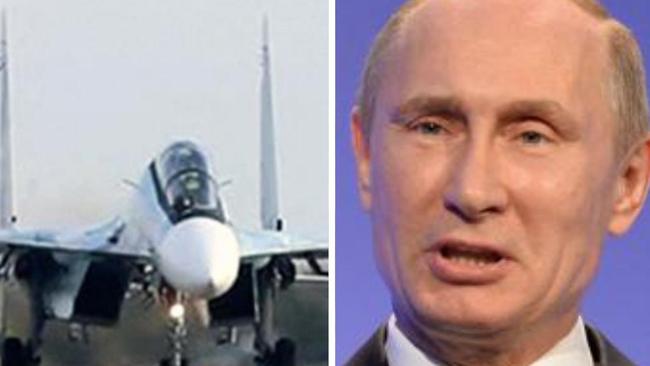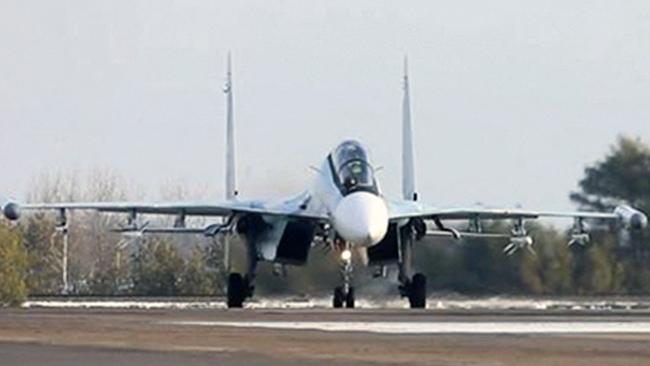Mystery behind Russia not using advanced combat jets
There’s one thing that Russia was expected to do after it invaded Ukraine – and military analysts are stumped as to why it hasn’t.

Innovation
Don't miss out on the headlines from Innovation. Followed categories will be added to My News.
They’re shiny. They’re gadgety. They’re ridiculously expensive. But are they also useless? Military analysts are stumped as to why Russia has launched a massive military campaign – but not used its advanced combat jets.
The process has been well defined since World War II.
Send in your precision-strike missiles first. Use these to destroy radars, anti-aircraft weapons and crater runways to prevent an opponent’s aircraft from flying.
Then send in your aircraft to keep the skies clear and respond to any calls for help from the troops and tanks advancing below.
But Russian President Vladimir Putin hasn’t done this.
Stream the latest news on the escalating tensions between Russia and Ukraine live & on demand on Flash. 25+ news channels in 1 place. New to Flash? Try 1 month free. Offer ends 31 October, 2022 >
Whatever was shot down over Kyiv was pretty big pic.twitter.com/aV6a3VwPgX
— OSINTtechnical (@Osinttechnical) February 25, 2022
“Russia’s air force is missing in action, and largely unused,” CNA think tank Russia studies director Michael Kofman says. “In the first [few] days, Russian tactical aviation, except for some Su-25s, largely sat on the sidelines. So have most combat helicopters. They have hundreds of both deployed in the area.”

The mystery remains why.
Military analysts are picking through the evidence to understand what’s going on.
Did the opening guided-missile barrage fail to clear the way?
Does Russia have the ability to co-ordinate its forces properly?
Is there a fear of friendly fire?
Is there enough advanced guided ammunition?
Is it something else? Or all of the above?
Control of the skies
“The logical and widely anticipated next step, as seen in almost every military conflict since 1938, would have been for the Russian Aerospace Forces (VKS) to mount large-scale strike operations to destroy the Ukrainian Air Force,” RUSI think tank research fellow Justin Bronk says.
“This did not happen.”
Instead, the overwhelming force of about 300 combat aircraft Russia has positioned around Ukraine has sat mainly on the ground. At least until now.
Most of the air activity over Ukraine remains ambiguous. Both sides use very similar aircraft and helicopters.
Russian 🇷🇺 SU-25 in the area of Kherson taking a direct hit by the missile of a Ukrainian MANPADS (Man-portable air-defense system).
— Felix Woessner (@FeWoessner) February 26, 2022
via WarLeaks @jpg2t785#Ukrainepic.twitter.com/02IzvOrswi
The Su-25 “Frogfoot” ground attack aircraft, in particular, is used by both Russia and Ukraine. And they cannot be told apart in the distant photos and social media footage, meaning any nationality claims must be suspect.
It’s a problem the combat forces themselves must contend with.
A Ukrainian Su-27 “Flanker” fighter was shot down over Kyiv in the war’s opening days. Whether by defensive or Russian forces remains unclear.
Reported canopy frame section from #Ukraine 🇺🇦 Su-27 Flanker crash in Kyiv overnight 24/25 February - recovery away from the main wreckage indicating ejection.
— Joseph Dempsey (@JosephHDempsey) February 26, 2022
https://t.co/EwShKThT2Zpic.twitter.com/njnEDmM6eV
But, unlike the recent wars in Iraq and Bosnia, combat air power is making a minimal appearance. And that’s odd given the pride Russia displays in its air technology.
“They’re not flying CAPs [combat air patrols], or offensive counter-air, and only [yesterday] have I spotted the first Su-34 bomber conducting strikes,” Mr Kofman says.
On a wing and a prayer
Ukraine’s major radar systems may be blinded. But satellite photos reveal few of its military airfield runways appear cratered.
Not that its operational aircraft are likely still there anyway.
46/ Evidence that Ukraine relocated air force assets in anticipation of Russian strikes on airbases, which do not seem to have successfully eliminated Ukraine's ability to contest the skies https://t.co/RJjWqhCAJf
— Evan Hill (@evanhill) February 26, 2022
Regardless, says Mr Bronk, Ukraine’s air force should have been overwhelmed by now.
“[Russian] Su-35 and Su-30 fighters would have overwhelmed the Ukrainian fighters, even if they did manage to take off for sorties conducted at very low altitudes with limited situational awareness. This did not happen.”
The consequence is Ukraine’s air force can make pinpoint strikes on advancing tank columns.
“Multiple Russian columns have been sent forward beyond the reach of their air defence cover, and in other cases accompanying SAM batteries have been caught inactive in military traffic jams,” Mr Bronk says.
On further inspection these images actual show remains of 2 different #Ukraine Air Force 🇺🇦 Su-25 Frogfoot
— Joseph Dempsey (@JosephHDempsey) February 27, 2022
Blue 19
Blue ?? pic.twitter.com/1Qd1jSLQdn
They’re also intercepting Russian attack helicopters and possibly paratroop-carrying transport aircraft.
“The fact that Ukrainian troops and civilians have been able to see [and rapidly mythologise] their own pilots continuing to fly sorties above major cities has also been a major morale-boosting factor,” Mr Bronk says.
One such story is most likely a myth: The “Ghost of Kyiv” is supposedly a lone Ukrainian fighter pilot who has already shot down more than five Russian aircraft over the capital.
Instead, most Russian aircraft losses are likely to be to both its own ground-based air defences and those defending units that remain.
Putin the Unready?
Military analysts are speculating that Russia may have the aircraft. But it doesn’t have the advanced ammunition needed to make them effective.
It’s a problem already observed in Moscow’s air operations over Syria.
“During combat operations over Syria, only the Su-34 fleet has regularly made use of [precision-guide munitions] PGMs, and even these specialist strike aircraft have regularly resorted to unguided bomb and rocket attacks,” Mr Bronk says.
While extent of #Russia 🇷🇺 strikes against Vasylkiv air base are unclear another undated image from the same building showing debris indicates an operational #Ukraine 🇺🇦 air force Su-27 pic.twitter.com/1g7pVpNd7P
— Joseph Dempsey (@JosephHDempsey) February 26, 2022
“This, combined with the lack of targeting pods to spot and identify battlefield targets from a safe distance, means that the [Russian] fixed-wing pilots’ capacity to provide close air support for their forces is limited.”
Whatever the case, the Kremlin’s forces do not appear to be operating in a mutually supporting, cooperative way.
“Looking at the military effort, I think Russian forces are getting some basics really wrong. They’re not really fighting the way they train and organise for a major conventional war,” Kofman says.
“It seems they tried to win quickly and cheaply via ‘thunder runs,’ hoping to avoid the worst of sanctions and Western outrage. They’ve ended up in the worst of all worlds, trickling more resources into a failed strategy.”
But the war has only just begun.
Su-34 over Kharkiv. A bad sign about the trajectory of the war, suggests the Russian military has begun to use tactical aviation for bombing. Previously we only saw support from Su-25 attack aircraft. https://t.co/QTa4MwjXCS
— Michael Kofman (@KofmanMichael) February 28, 2022
“The truth is that large parts of the Russian military have yet to enter this war, with many of the capabilities still unused,” Mr Kofman says. “Not to take away from Ukraine’s great military performance and resilience, but I see a lot of early judgments and conclusions that need moderation.”
So, what’s next?
“Russia’s political leadership is still not conceding their plan’s failure, trying to take Kyiv quickly. But we’re seeing them open up greater use of fires, strikes and air power,” he says.
“Sadly, I expect the worst is yet ahead, and this war could get a lot more ugly.”
Jamie Seidel is a freelance writer | @JamieSeidel
Originally published as Mystery behind Russia not using advanced combat jets





